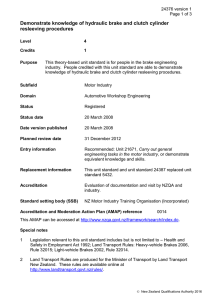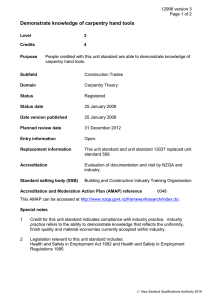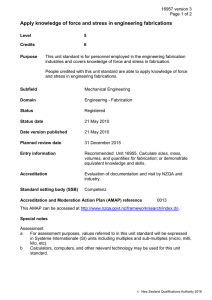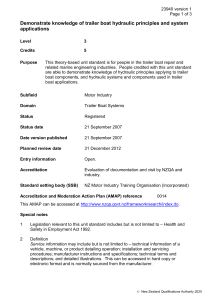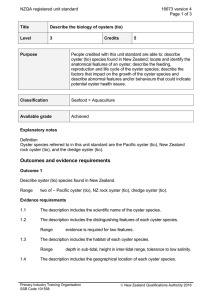Operate and perform routine maintenance on load-shifting equipment
advertisement
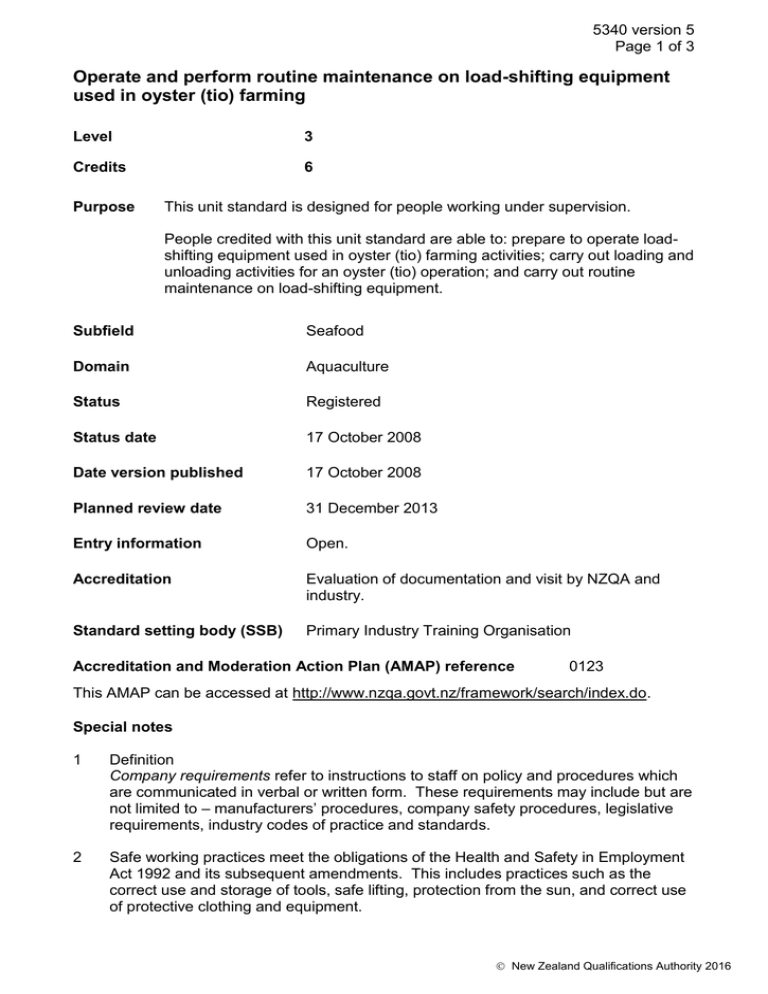
5340 version 5 Page 1 of 3 Operate and perform routine maintenance on load-shifting equipment used in oyster (tio) farming Level 3 Credits 6 Purpose This unit standard is designed for people working under supervision. People credited with this unit standard are able to: prepare to operate loadshifting equipment used in oyster (tio) farming activities; carry out loading and unloading activities for an oyster (tio) operation; and carry out routine maintenance on load-shifting equipment. Subfield Seafood Domain Aquaculture Status Registered Status date 17 October 2008 Date version published 17 October 2008 Planned review date 31 December 2013 Entry information Open. Accreditation Evaluation of documentation and visit by NZQA and industry. Standard setting body (SSB) Primary Industry Training Organisation Accreditation and Moderation Action Plan (AMAP) reference 0123 This AMAP can be accessed at http://www.nzqa.govt.nz/framework/search/index.do. Special notes 1 Definition Company requirements refer to instructions to staff on policy and procedures which are communicated in verbal or written form. These requirements may include but are not limited to – manufacturers’ procedures, company safety procedures, legislative requirements, industry codes of practice and standards. 2 Safe working practices meet the obligations of the Health and Safety in Employment Act 1992 and its subsequent amendments. This includes practices such as the correct use and storage of tools, safe lifting, protection from the sun, and correct use of protective clothing and equipment. New Zealand Qualifications Authority 2016 5340 version 5 Page 2 of 3 3 Regulatory requirements include but are not limited to – the Animal Products Act 1999. 4 Load-shifting equipment used may vary according to what is available on site and may include but is not limited to – vehicle-mounted cranes (Hiabs), tractors with hydraulic lifts, chain-block and gantries, hydraulic equipment. Evidence is required for one type of lifting equipment. Elements and performance criteria Element 1 Prepare to operate load-shifting equipment used in oyster (tio) farming activities. Performance criteria 1.1 Pre-use checks are conducted to identify any defects in accordance with company requirements. Range checks may include – condition of hydraulic hoses and seals, hydraulic fluid and oil levels, wire, chain, brakes, tyres, anchor points, attachment of lifting equipment. 1.2 Actions taken or notifications given with respect to identified defects meet company requirements. 1.3 Equipment is prepared in accordance with company requirements. Element 2 Carry out loading and unloading activities for an oyster (tio) operation. Performance criteria 2.1 Stability considerations are described in terms of the loaded load-shifting equipment, and the load itself. 2.2 Stability of the load is maintained throughout the loading and unloading operation. 2.3 The load is positioned precisely and securely at its destination. 2.4 Observation of the environment, load, and load handling attachment position is maintained during movement toward and away from the stacking and destacking position. Range environment – immediate vicinity of operation, other machines, other stacks of materials, personnel, structures. New Zealand Qualifications Authority 2016 5340 version 5 Page 3 of 3 2.5 Operation is completed without damage to equipment, other stacks of materials, structures, personnel, and load. 2.6 Safe work practices are used in accordance with company requirements. Element 3 Carry out routine maintenance on load-shifting equipment. Performance criteria 3.1 Routine maintenance is completed in accordance with company procedures. Range chain-block and gantry – greasing, rust prevention; hydraulic lifts – greasing, maintaining hydraulic fluid level, rust prevention; tractor with hydraulic lift – tyre pressures, brake fluid level, rust prevention, oil level. Please note Providers must be accredited by NZQA, or an inter-institutional body with delegated authority for quality assurance, before they can report credits from assessment against unit standards or deliver courses of study leading to that assessment. Industry Training Organisations must be accredited by NZQA before they can register credits from assessment against unit standards. Accredited providers and Industry Training Organisations assessing against unit standards must engage with the moderation system that applies to those standards. Accreditation requirements and an outline of the moderation system that applies to this standard are outlined in the Accreditation and Moderation Action Plan (AMAP). The AMAP also includes useful information about special requirements for organisations wishing to develop education and training programmes, such as minimum qualifications for tutors and assessors, and special resource requirements. Comments on this unit standard Please contact the Primary Industry Training Organisation standards@primaryito.ac.nz if you wish to suggest changes to the content of this unit standard. New Zealand Qualifications Authority 2016


